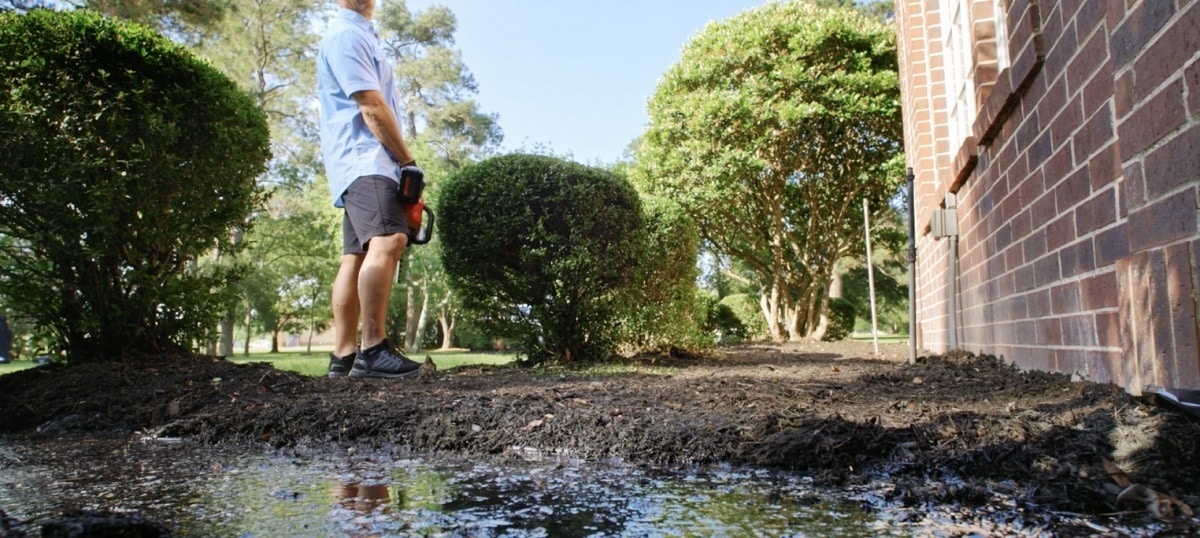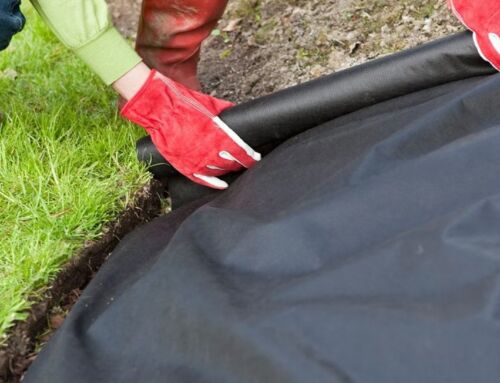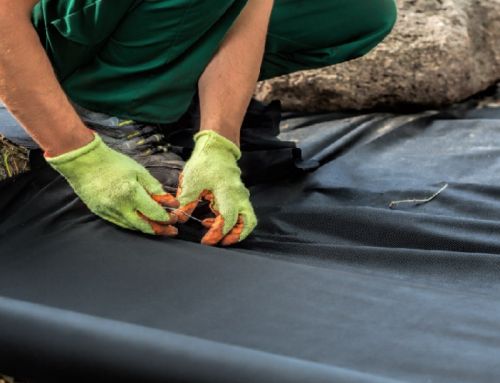When it comes to your garden, water can be your best friend or your worst enemy.
In Sydney, with its unique climate mix of sun-drenched summers and torrential downpours, managing landscape drainage is not just a matter of convenience but a necessity.
Without proper drainage, your garden or outdoor space can quickly turn into a swamp or, worse, undermine the very foundations of your home.
To help you protect your property, save time and keep money in your pocket, we’ll show you how to solve common landscape drainage problems. We’ll also round up the top factors to consider when choosing your solution.
From soil erosion and water pooling to downspout issues and subsurface water troubles, understanding these challenges is pivotal.
Read on for a simple breakdown of potential problems and proven fixes.
10 Practical Drainage Solutions
#1 – The Slope Solution: Grading Your Garden
A foundational approach to addressing drainage issues is to ensure your garden has the correct slope or grade. This involves subtly shaping the land to encourage water to flow away from your home and garden areas prone to pooling.
Proper grading can be achieved through landscaping adjustments, creating a slope of about 2-3% away from your house.
- Prevents water from pooling around your home’s foundation.
- Reduces the risk of soil erosion in your garden.
- Enhances the overall health of your lawn and plants by preventing waterlogged soil.
Action Steps:
- Consult with a landscaping professional to assess and implement the correct grade for your garden.
- Consider incorporating landscape features that complement the grading, such as a dry creek bed or strategically placed garden beds to assist with water diversion.
#2 – Rain Gardens: Nature’s Sponge
Rain gardens are shallow, constructed depressions filled with deep-rooted native plants and grasses. They are designed to absorb and filter runoff water from impervious surfaces like roofs and driveways.
Positioned at least 10 feet away from your home, they can significantly reduce water pooling and improve water quality.
- Reduces runoff, preventing water from overwhelming stormwater systems.
- Filters pollutants, improving the quality of local waterways.
- Attracts beneficial wildlife, enhancing biodiversity in your garden.
Action Steps:
- Choose native plants for your rain garden that are adapted to your area’s soil and climate conditions.
- Work with a landscape designer to ensure proper placement and optimal functionality of your rain garden.
#3 – French Drains: The Underground Solution
A French drain consists of a trench filled with gravel or rock containing a perforated pipe, which redirects surface water and groundwater away from an area.
It’s an effective solution for removing excess water from soggy lawns and preventing water from penetrating your basement.
- Provides an invisible solution to drainage problems.
- Protects your home’s foundation from water damage.
- Can be integrated into the landscape design for aesthetic appeal.
Action Steps:
- Determine the most effective route for the drain, ensuring it slopes away from your house.
- Consider professional installation to ensure the correct depth, slope, and placement of the pipe.
#4 – Swales: The Gentle Moat
Swales are shallow trenches that follow the contour of your landscape, designed to capture runoff and direct it away from your home.
They can be grassed or filled with pebbles and plants, making them an attractive landscape feature as well as a practical drainage solution.
- Slows down runoff, allowing water to infiltrate into the soil.
- Reduces the need for irrigation by directing water to areas where it’s needed.
- Enhances the aesthetic appeal of your landscape.
Action Steps:
- Incorporate swales into your garden design in a way that complements the natural landscape.
- Plant water-tolerant species along swales to maximise their water absorption capabilities.
#5 – Dry Wells: The Hidden Reservoirs
Dry wells are underground structures that collect and allow rainwater to slowly infiltrate into the ground, preventing it from flooding areas of your landscape. They are particularly useful in areas where other drainage solutions are not feasible.
- Reduces surface water pooling and flooding.
- Minimises the impact on municipal stormwater systems.
- Can be combined with other drainage solutions for maximum efficiency.
Action Steps:
- Use a dry well in conjunction with gutters and downspouts to manage roof runoff effectively.
- Ensure the dry well is appropriately sized and placed away from your home’s foundation.
#6 – Gutter Guards: The First Line of Defence
Keeping your gutters free from leaves and debris is crucial in preventing water from spilling over and saturating the ground near your foundation. Gutter guards can be installed to minimise the maintenance required to keep your gutters clear.
- Prevents blockages in gutters and downspouts, ensuring efficient water flow.
- Reduces the frequency of gutter cleaning, saving time and effort.
- Protects against water damage to your home’s exterior and foundation.
Action Steps:
- Choose gutter guards that are compatible with your existing gutters and suitable for the type of foliage around your home.
- Regularly inspect and maintain your gutters, even with guards installed, to ensure optimal performance.
#7 – Permeable Paving: The Porous Pathway
Permeable paving materials allow water to pass through the surface and into the ground beneath, reducing runoff and improving water quality. Options include pervious concrete, porous asphalt, and interlocking pavers.
- Reduces runoff and the risk of flooding.
- Replenishes groundwater supplies.
- Offers a durable and visually appealing surface for driveways, walkways, and patios.
Action Steps:
- Consider the specific needs of your landscape when selecting permeable paving materials.
- Work with a professional to ensure proper installation and maximisation of water infiltration.
#8 – Catch Basins: The Stormwater Sentries
Catch basins are designed to collect and transport excess stormwater to local waterways or drainage systems, preventing water from pooling in low-lying areas. They are typically installed at points where runoff is most problematic.
- Effectively captures and diverts large volumes of water.
- Reduces the chance of flooding and water damage to landscapes and structures.
- Can be discreetly integrated into the landscape.
Action Steps:
- Regularly clean and maintain catch basins to prevent blockages.
- Strategically place catch basins in areas known for excessive water accumulation.
#9 – Green Roofs: The Elevated Oasis
Green roofs involve growing vegetation on rooftops, which can absorb rainwater, provide insulation, and reduce urban heat island effects. While more common in commercial buildings, residential applications are growing in popularity.
- Reduces runoff and improves stormwater management.
- Enhances energy efficiency by providing natural insulation.
- Increases biodiversity and provides a habitat for wildlife.
Action Steps:
- Consult with a specialist to ensure your roof structure can support the additional weight.
- Choose plant species that are drought-resistant and suitable for the Sydney climate.
#10 – Downspout Extensions: The Simple Stretch
Extending your downspouts further away from your home’s foundation can significantly reduce the risk of water damage. By directing water further into your garden or a drainage solution like a French drain, you can protect your property effectively.
- A simple and cost-effective way to improve existing drainage.
- Prevents water from pooling around the foundation.
- Can be easily integrated into your landscape design.
Action Steps:
- Ensure extensions are long enough to divert water away from the foundation effectively.
- Consider using decorative splash blocks or integrating extensions into your garden design for added aesthetic appeal.
Each of these options offers a unique approach to solving common drainage problems in Sydney.
By understanding the benefits and implementation suggestions, you can make informed decisions that protect your property and enhance your outdoor space.
Factors to Consider in Your Drainage Solution Journey
Landscape Layout and Soil Type
A thorough understanding of your property’s topography, including slopes, natural water paths, and low points, is essential.
For instance, properties with a natural slope may benefit greatly from simple solutions like grading or swales, which utilise gravity to direct water flow.
Flat terrains might require more complex systems like French drains or dry wells to effectively manage water.
Soil type is another critical factor, as it directly impacts water infiltration and retention capabilities. Sandy soils, with their high permeability, allow water to drain quickly, potentially making options like rain gardens or permeable paving effective.
Clay soils, known for their poor drainage, might necessitate more robust solutions such as French drains or catch basins to prevent waterlogging and pooling.
Conducting a soil test can provide valuable insights into its composition, helping you choose the most suitable drainage intervention.
5 Common (and Eye-Catching) Landscaping Styles to Consider: Sydney Edition
Local Climate and Rainfall Patterns
In areas prone to heavy downpours, systems capable of handling large volumes of water, such as catch basins and French drains, might be necessary to prevent flooding and water damage.
Meanwhile, for regions experiencing more moderate rainfall, simpler solutions like gutter guards or downspout extensions could suffice in keeping water away from your property’s foundation.
Considering the frequency and intensity of rain events can help in designing a drainage system that is both efficient and cost-effective.
For instance, in areas with sporadic, heavy rainfall, investing in a comprehensive system that includes both surface and subsurface drainage solutions might be warranted.
Environmental Impact and Sustainability
Sustainable options like rain gardens, green roofs, and permeable paving not only address drainage issues but also contribute positively to the environment.
These solutions can help reduce runoff, improve water quality, and even enhance local biodiversity. Choosing eco-friendly options demonstrates a commitment to preserving the natural ecosystem while effectively managing water on your property.
Systems that require minimal upkeep, reduce water usage or repurpose runoff in beneficial ways offer both environmental and practical advantages.
Budget and Maintenance Considerations
Some options, such as installing French drains or dry wells, might entail higher upfront costs but offer long-term relief with minimal maintenance.
On the other hand, solutions like rain gardens or permeable paving can be more cost-effective to install but may require regular upkeep to maintain their effectiveness.
Consider not only the cost of materials and installation but also the potential savings in terms of reduced water damage repair and enhanced property value.
Assess your capacity and willingness to perform necessary maintenance tasks or the need to hire professionals. Selecting a solution that fits your budget and lifestyle ensures that your drainage system remains effective and manageable over time.
Take the Next Step Towards a Dry and Beautiful Landscape!
Ready to transform your yard from waterlogged to wonderful?
Let us help you navigate the world of landscape drainage with confidence and expertise.
At Manna Landscapes, our team of professionals is dedicated to providing tailored solutions that meet your unique needs and preferences.
Whether you’re facing persistent drainage issues or simply looking to enhance the beauty and functionality of your outdoor space, we’re here to assist you every step of the way.
Contact us today for a 100% obligation-free Design Consultation or a detailed quote.



